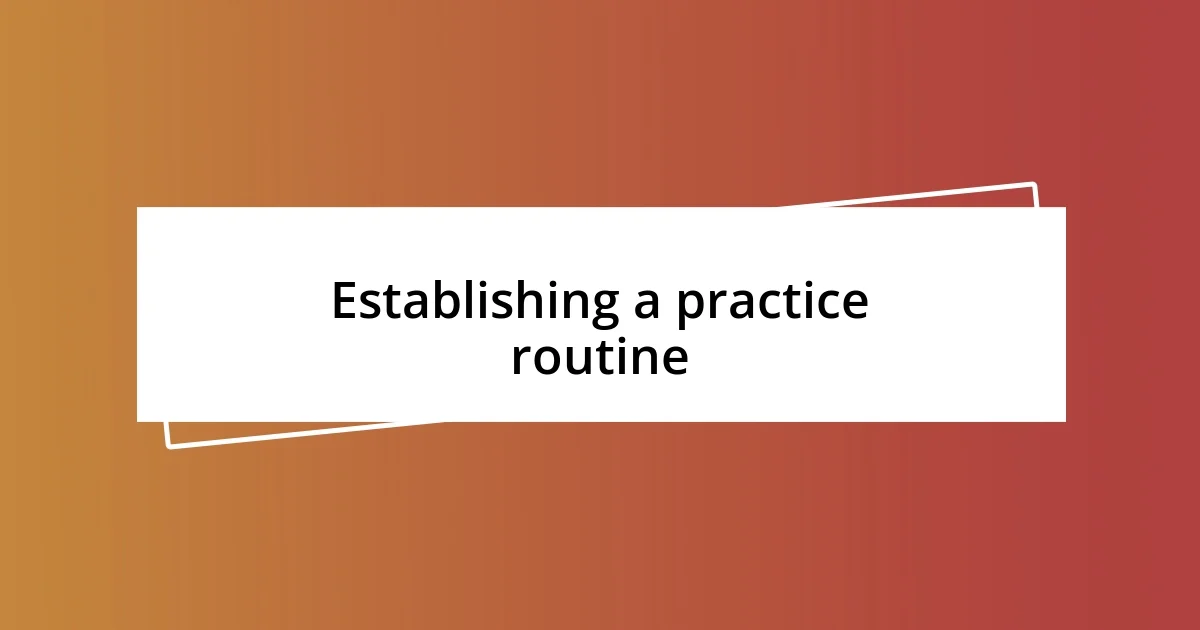Key takeaways:
- Consistency and setting specific goals enhance focus and motivation in music practice.
- Incorporating techniques like slow practice, ear training, and mental visualization leads to skill improvement and confidence.
- Tracking progress and connecting with other musicians fosters motivation and a sense of accomplishment in the learning journey.

Establishing a practice routine
When I first started developing my practice routine, I realized that consistency was key. I dedicated specific times during the day when I felt most alert, and it made all the difference. Have you noticed how much easier it is to focus when you practice at the same time every day?
I found that breaking my sessions into smaller, manageable chunks helped me stay motivated. For instance, I would tackle scales for 15 minutes before switching to a piece I loved. This way, I felt accomplished without feeling overwhelmed—doesn’t that sound more enjoyable?
Setting specific goals for each practice session has also transformed my approach. Instead of just mindlessly playing through my pieces, I would focus on a particular section or skill. This practice strategy brought me a sense of purpose, and I often celebrated small victories, like nailing a tricky passage. How about you? Have you ever celebrated those little wins? They’re crucial for maintaining enthusiasm!

Setting specific goals
Setting specific goals in my music practice has been a game changer. I remember when I used to sit down and play without any clear direction. It felt aimless and often led to frustration. Now, I take a moment at the beginning of each session to pinpoint what I want to achieve. This intentionality not only keeps me motivated but also transforms my practice time into something much more meaningful.
Here are some strategies I’ve found helpful when setting my goals:
- Focus on one or two specific techniques, like mastering vibrato or improving rhythm.
- Choose a challenging piece and break it down into small sections, targeting one each session.
- Set a timeline for achieving these goals, whether it’s for a week, a month, or leading up to a performance.
- Reflect on progress by jotting down what worked well and what needs improvement after each practice.
By making my goals specific, I often walk away from my sessions feeling accomplished and eager for what’s next. It fuels my passion and lets me embrace the journey of learning music.

Techniques for effective practice
Practicing doesn’t just involve playing notes; it’s about using effective techniques to truly enhance your skills. One method I swear by is the “slow practice” approach. In my experience, when I intentionally slow down difficult passages, I can focus on accuracy and technique. There’s something powerful about breaking it down note by note before gradually increasing the tempo. Have you ever noticed how much more you absorb when you take your time?
Another technique that’s worked wonders for me is incorporating ear training into my regular practice. I remember feeling a bit lost when I first attempted to play by ear. However, dedicating part of my sessions to identifying intervals and recognizing chords made me a more versatile musician. It’s like unlocking a new level in a game—suddenly, improvisation and playing seamlessly with others became so much easier. Isn’t it amazing how much your understanding deepens when you learn to listen?
Lastly, I can’t overlook the importance of recording my practice sessions. Initially, I felt hesitant to hit record, fearing I wouldn’t sound perfect. But listening back often reveals insights I’d miss in the moment. It’s also a great way to track progress over time. Have you ever experienced that moment of surprise hearing how far you’ve come? This technique enriches my journey and keeps me grounded in my development.
| Technique | Description |
|---|---|
| Slow Practice | Focusing on accuracy and technique by playing difficult passages slowly. |
| Ear Training | Incorporating activities to identify intervals and chords to enhance versatility. |
| Recording Practice | Listening back to sessions to gain insights and track progress. |

Utilizing technology for practice
Utilizing technology for practice has added a whole new dimension to my musical journey. I vividly remember when I downloaded a metronome app; it transformed my sense of timing. No longer did I struggle with tempo during practice. Instead, I could set the pace and really focus on aligning my rhythm with the beat. Have you ever felt how a steady beat can completely change your play?
I’ve also found that using recording apps has been immensely beneficial. At first, I was nervous about capturing my music, worried that I wouldn’t sound good enough. But I took the plunge, and I can’t express how enlightening it was to listen to my past sessions. It’s like turning on a light in a dim room—you suddenly see areas that need work and those little victories that spark joy in your practice. Has listening back ever given you an inkling of how far you’ve come?
Beyond that, I utilize music-learning platforms for guided practice. I discovered these through a friend’s recommendation, and honestly, they introduced me to a whole treasure trove of resources. Getting feedback from virtual instructors and following structured lessons really sharpens my skills. I remember a specific moment when an online lesson helped me nail a tricky section I’d been struggling with for weeks. The blend of technology and traditional methods truly enhances my learning experience. How has technology influenced your own practice routine?

Incorporating mental visualization
Incorporating mental visualization into my music practice has truly elevated my skills. I often close my eyes and picture myself performing a piece flawlessly, imagining the notes flowing effortlessly from my fingertips. This technique not only builds my confidence but also helps me mentally “rehearse” difficult passages when I can’t physically practice, creating a strong mental blueprint. Has this kind of imagery ever struck a chord with you?
When I visualize, I see myself on stage, completely immersed in the music. The thrill of connecting with the audience energizes me, and it’s that vivid imagery that fuels my dedication during practice. I remember a time before a big recital when I visualized each measure while I sat quietly in a corner. It calmed my nerves and made the performance feel familiar rather than intimidating. How does imagining your success impact your own performance mindset?
Furthermore, I find that marrying mental visualization with physical practice creates a dynamic synergy. After a rigorous session, I take a moment to sit back and mentally replay what I just played, envisioning myself executing it perfectly. This kind of reflective practice cements the technique and feel of the music in my mind. I can’t help but wonder: isn’t it fascinating how our brains can connect physical movement to mental imagery, enhancing our overall performance?

Tracking progress and milestones
Tracking progress and milestones in my music practice has become an essential part of my journey. I’ve started keeping a journal where I jot down little victories, like mastering a challenging scale or finally hitting that high note. Each entry feels like a personal celebration, and when I look back, it’s truly satisfying to see how far I’ve come. Have you ever realized that documenting your progress can be a source of motivation?
I also implemented a visual chart to track my daily practice times and specific goals. Each checkmark feels like a badge of honor, and the visual representation of my consistent effort inspires me to stay committed. I recall a particularly tough week where my motivation dipped. But seeing all those checkmarks reminded me that I was still making progress, even in the smallest increments. Don’t you think having a visual cue can help maintain focus?
Reflecting on milestones is another crucial aspect of this process. I set periodic review points, like monthly assessments, to evaluate my skills. Recently, I took a step back and assessed my improvement with a favorite piece I had struggled with earlier in the year. The difference was astonishing! It’s moments like these that reaffirm my commitment to practice. Have you ever taken the time to celebrate your achievements and truly appreciate your growth?

Staying motivated in practice
Staying motivated in practice is crucial for my growth as a musician, and I often find inspiration in setting small, achievable goals. For instance, on days when I feel less inclined to pick up my instrument, I tell myself to simply play for ten minutes. More often than not, I get lost in the music, and that humble start leads to lengthy practice sessions. Have you ever noticed how just showing up can ignite your inner drive?
I’ve also experimented with varying my practice routine to keep things fresh and exciting. Switching genres or exploring new techniques can rejuvenate my enthusiasm and spark creative ideas. One time, I decided to switch from classical to jazz for a week, and I was amazed at how the improvisational aspects opened up my musical expression. What’s your go-to method for switching things up when practice starts to feel stale?
Connecting with other musicians has proven invaluable in maintaining my motivation. Whether it’s joining online forums, taking part in local jam sessions, or simply sharing experiences with friends, these interactions reignite my passion for music. I vividly remember a session where a fellow musician offered constructive feedback on my performance, and that exchange fueled my dedication to improve further. How has collaborating with others enriched your own musical journey?














